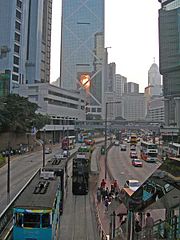Roadway noise
Roadway noise is the most prevalent form of environmental noise. Pictured: São Paulo, Brazil.
Roadway noise is the collective sound energy emanating from motor vehicles. In the USA it contributes more to environmental noise exposure
[1] than any other noise source, and is constituted chiefly of engine, tire, aerodynamic and braking elements. In other Western countries as well as Lesser developed countries, roadway noise is expected to contribute a proportionately large share of the total societal noise pollution.
History
Hong Kong roadway generating noise to adjacent land uses.
Roadway noise began to be measured in a widespread manner in the 1960s, when computer modeling of this phenomenon was perfected. After passage of the National Environmental Policy Act and Noise Control Act,
[2] the demand for detailed analysis soared, and decision makers began to look to acoustical scientists for answers regarding the planning of new roadways and the design of noise mitigation.
Partial bans on motor vehicles from urban areas have been shown to have minimal impacts upon reducing sound levels (as would become clear from later modeling studies); for example, the partial ban in Gothenburg, Sweden resulted in minuscule reduction of sound levels.
[3]


No comments:
Post a Comment